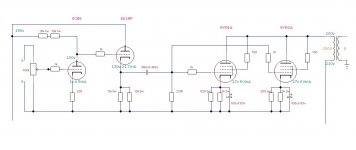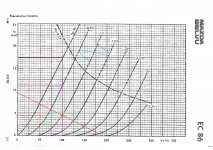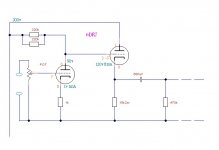A few years ago I listened to a preamp at an exhibition that impress me for good sound quality ... schematic was roughly the one on the right ... I couldn't find any feedback on the net and I don't know if I understood the meaning of it. .. I still tried to adapt it with different tubes and new parameters ... what do you think about it?
Attachments
Last edited:
A few years ago I listened to a preamp at an exhibition that impress me for good sound quality ... schematic was roughly the one on the right ... I couldn't find any feedback on the net and I don't know if I understood the meaning of it. .. I still tried to adapt it with different tubes and new parameters ... what do you think about it?
...i forgot: pre provided Vg p-p 4v
Last edited:
Why 6080?
With Ecc88 onf first gain stage and a CF you can get more than 20dB of gain at low zout.
With 6N6 or 6H30 you will have a lower gain and lower Zout
The Vdc can be 200 volt
Walter
With Ecc88 onf first gain stage and a CF you can get more than 20dB of gain at low zout.
With 6N6 or 6H30 you will have a lower gain and lower Zout
The Vdc can be 200 volt
Walter
Why 6080?
With Ecc88 onf first gain stage and a CF you can get more than 20dB of gain at low zout.
With 6N6 or 6H30 you will have a lower gain and lower Zout
The Vdc can be 200 volt
Walter
evidently he wished Zout even lower and a much higher current reserve.
With 6H30 you have a very low Z
For a preamp why you need current?
Walter
Maybe because with the price of 2 6H30 you can buy all the components of the circuit apart from the power supply and OTs 😉
Any tube will do in that position, a cathode follower is a topology that doesnt provide "colour" to the sound, you could even put a wimpy 12ax7 (requires changing cathode resistor like any other different tube) because the driver requeriments of a 6y6 in that configuration are not very high, if you have 6n1p, 6n6p, 12au7, 6sn7, ecc88 variants they will all be equally good in that position.
Any tube will do in that position, a cathode follower is a topology that doesnt provide "colour" to the sound, you could even put a wimpy 12ax7 (requires changing cathode resistor like any other different tube) because the driver requeriments of a 6y6 in that configuration are not very high, if you have 6n1p, 6n6p, 12au7, 6sn7, ecc88 variants they will all be equally good in that position.
But isn't it always better to use a valve like 6S19P which is more suitable for impedance drop?
I was also wondering if this circuit has a distinctive name in English ...
In case you can use 6N6, quite similar to 6H30 and cheap but fine and linear.
In addition you are looking for quality or to save money?
Both are difficult to find
Walter
In addition you are looking for quality or to save money?
Both are difficult to find
Walter
I think you are confusing two different topologies the low impedance of the driver in the circuit you put has no other use but burden the heater and HV supply.But isn't it always better to use a valve like 6S19P which is more suitable for impedance drop?
I was also wondering if this circuit has a distinctive name in English ...
The AC coupled output stage is indeferent because it doesnt need that low impedance to work properly, if it were a A2 it would, but like your diagram shows it won't notice if its a mosfet or a triode, you only need a couple miliamps of standing current to cope with miller capacitance to have good HF response, in A2 class you will need a low impedance driver to cope with the grid current when signal goes positive over cathode, nevertheless the design of the driver stage and the selection of the power and driver tubes in a A2 SE isnt as trivial as an AC coupled SE.
Last edited:
The question you were asking was not so clear to me. It's the preamp you want to build? And you want to use less expensive tubes? You can use any 6DJ8 variant on the front, including 6N23P. The 6AS7 is already inexpensive. I'm not sure if there is a new production equivalent; I think maybe a 6C41C is maybe a good choice.
In case you can use 6N6, quite similar to 6H30 and cheap but fine and linear.
In addition you are looking for quality or to save money?
Both are difficult to find
Walter
EC86 seems to have a good linearity and a strong built.
Attachments
I think you are confusing two different topologies the low impedance of the driver in the circuit you put has no other use but burden the heater and HV supply.
The AC coupled output stage is indeferent because it doesnt need that low impedance to work properly, if it were a A2 it would, but like your diagram shows it won't notice if its a mosfet or a triode, you only need a couple miliamps of standing current to cope with miller capacitance to have good HF response, in A2 class you will need a low impedance driver to cope with the grid current when signal goes positive over cathode, nevertheless the design of the driver stage and the selection of the power and driver tubes in a A2 SE isnt as trivial as an AC coupled SE.
in fact I still have as much confusion, ac or dc coupling, as it is essential to have a low Zout and a large reserve of current.
The question you were asking was not so clear to me. It's the preamp you want to build? And you want to use less expensive tubes? You can use any 6DJ8 variant on the front, including 6N23P. The 6AS7 is already inexpensive. I'm not sure if there is a new production equivalent; I think maybe a 6C41C is maybe a good choice.
No, I would like to build something similar to the amplifier which is on the left. I would also like to compare it, with the same wattage with the pentode version with a single tube that I already built. I took as an excuse the scheme of that pre to try to imagine it inside the amplifier. Reading the explanations of the person who designed it, I persuaded myself that it could be a good solution also in the future perspective of other projects.
As for EC86: it has a lower commercial value than the 6DJ8 standard and, with the same construction quality (for example with an E88CC SE), a price 10 times lower.
Build what you drew in post #1, but use a 6CG7 instead.
There's nothing wrong with using the 6080. You could just plug in a 6BL7 or 6BX7 if you wanted something a little smaller.
There's nothing wrong with using the 6080. You could just plug in a 6BL7 or 6BX7 if you wanted something a little smaller.
Build what you drew in post #1, but use a 6CG7 instead.
There's nothing wrong with using the 6080. You could just plug in a 6BL7 or 6BX7 if you wanted something a little smaller.
yes, or, simplifying again, using a single tube.
Attachments
The capacitor is ridiculous high, it will take 5 minutes for the cap toyes, or, simplifying again, using a single tube.
charge if unloaded. Even if the loading is 10k it will take 6second to equilibrate.
A folie cap of 0.47 will do the job here.
The capacitor is ridiculous high, it will take 5 minutes for the cap to
charge if unloaded. Even if the loading is 10k it will take 6second to equilibrate.
A folie cap of 0.47 will do the job here.
Sorry, it would be 680 nF.
Yes, that is a good choice.Sorry, it would be 680 nF.
And i like the tube, like 7247 / 12dw7 but other spec.
- Home
- Amplifiers
- Tubes / Valves
- Cathode Follower, again



